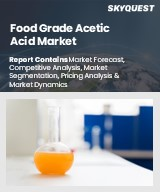
|
시장보고서
상품코드
1621734
그린 방부제 기회 및 촉진요인, 산업 동향 분석 및 예측(2024-2032년)Green Preservatives Market Opportunity, Growth Drivers, Industry Trend Analysis, and Forecast 2024 - 2032 |
||||||
세계 그린 방부제 시장은 2023년 14억 달러로 평가되었고, 2024-2032년간 연평균 7.2% 성장할 것으로 예상됩니다.
이러한 성장은 건강에 대한 인식과 환경에 대한 인식이 높아짐에 따라 천연 및 그린 방부제에 대한 소비자 수요가 증가하고 있기 때문입니다. 많은 소비자들이 식품, 퍼스널케어 제품 및 화장품에 함유된 합성 첨가물과 관련된 잠재적 건강 위험에 대해 우려하고 있습니다. 그 결과, 인공 방부제를 사용하지 않는 천연 대체품으로의 전환이 두드러지게 나타나고 있습니다. 시장은 천연 추출물과 유기산의 두 가지 주요 부문으로 나뉩니다.
천연 추출물은 2023년 약 9억 달러의 매출을 창출하며 시장을 장악할 것으로 예상됩니다. 이러한 인기는 클린 라벨 제품에 대한 소비자의 강한 선호와 식물성 성분에 대한 선호도가 높아졌기 때문으로 분석됩니다. 로즈마리, 님, 각종 에센셜 오일 등에서 추출한 추출물은 항균 및 항산화 작용을 하는 것으로 알려져 있습니다. 보다 안전하고 친환경적이라는 인식으로 다양한 산업 분야에서 널리 사용되고 있습니다. 구연산과 아스코르브산과 같은 화합물을 포함한 유기산 부문도 성장세를 보이고 있습니다.
이러한 산은 미생물의 증식을 억제하고 다양한 용도에서 유통기한을 연장하는 효과가 있는 것으로 평가받고 있습니다. 천연 추출물만큼 시장 점유율은 아니지만, 유기산은 비용 효율성과 제품 품질 유지 능력으로 인해 인기가 높아지면서 전체 시장 확대에 기여하고 있습니다. 용도별로는 식음료, 화장품 및 퍼스널케어, 제약, 기타 부문이 포함되며, 2023년 식음료 부문이 40.9%로 가장 큰 시장 점유율을 차지할 것으로 예상됩니다.
| 시장 범위 | |
|---|---|
| 시작 연도 | 2023년 |
| 예측 연도 | 2024년-2032년 |
| 시작 금액 | 1.4억 달러 |
| 예상 금액 | 2.6억 달러 |
| CAGR | 7.2% |
클린 라벨 제품에 대한 수요가 증가하면서 안전성을 보장하고 보존성을 높이기 위해 천연 방부제를 사용하는 제조업체가 늘어나면서 이 부문의 성장을 주도하고 있습니다. 또한, 소비자의 건강에 대한 인식이 높아지고 합성첨가물에 대한 규제가 강화되면서 특히 유기농 식품과 식물성 식품에 그린 방부제 사용을 촉진하고 있습니다. 미국 그린 방부제 시장만 해도 2023년 3억 5,540만 달러의 매출을 기록할 것으로 예상되며, 이는 자연 보존 방식에 대한 강한 선호를 보여줍니다. 지속 가능한 대체품으로의 전환은 건강에 대한 소비자의 인식이 높아지고 합성 방부제에 대한 규제가 강화됨에 따라 촉진되고 있습니다. 식품 및 음료 부문은 이러한 전환의 최전선에 있으며, 제조업체들은 클린 라벨과 유기농 제품을 중요시하고 있습니다. 또한, 화장품 및 퍼스널케어 산업은 그린 방부제를 사용함으로써 천연 성분에 대한 소비자의 선호에 부응하고 있으며, 이는 환경적 지속가능성이라는 광범위한 트렌드에 발맞추고 있습니다.
목차
제1장 조사 방법과 조사 범위
제2장 주요 요약
제3장 산업 인사이트
- 생태계 분석
- 밸류체인에 영향을 미치는 요인
- 이익률 분석
- 변혁
- 향후 전망
- 제조업체
- 유통업체
- 공급업체 상황
- 이익률 분석
- 주요 뉴스
- 규제 상황
- 영향요인
- 성장 촉진요인
- 천연으로 친환경 보존료에 대한 소비자 수요 증가
- 합성 보존료에 대한 규제 압력 증가
- 유기 식품 및 음료 산업 확대
- 산업 잠재적 리스크와 과제
- 합성 보존료에 비해, 친환경 보존료 제조 비용이 높다
- 일부 천연 보존료 보존 기간 유효성 한계
- 성장 촉진요인
- 성장 가능성 분석
- Porter's Five Forces 분석
- PESTEL 분석
제4장 경쟁 구도
- 서론
- 기업 점유율 분석
- 경쟁 포지셔닝 매트릭스
- 전략 전망 매트릭스
제5장 시장 규모와 예측 : 유형별, 2021-2032년
- 주요 동향
- 천연 엑기스
- 에센셜 오일
- 허브 추출물
- 식물 엑기스
- 유기산
- 구연산
- 젖산
- 아스코르브산
제6장 시장 규모와 예측 : 용도별, 2021-2032년
- 주요 동향
- 식품 및 음료
- 육류
- 유제품
- 음료
- 베이커리·스낵
- 기타(소스, 레디밀(Ready Meal) 등)
- 화장품 및 퍼스널케어
- 스킨케어 제품
- 헤어케어 제품
- 메이크업 제품
- 위생용품
- 기타(향료, 치약 등)
- 의약품
- 내복액
- 보충제
- 기타(외용 크림, 정제 등)
- 기타(농업, 포장 등)
제7장 시장 규모와 예측 : 지역별, 2021-2032년
- 주요 동향
- 북미
- 미국
- 캐나다
- 유럽
- 영국
- 독일
- 프랑스
- 이탈리아
- 스페인
- 러시아
- 아시아태평양
- 중국
- 인도
- 일본
- 한국
- 호주
- 라틴아메리카
- 브라질
- 멕시코
- 중동 및 아프리카
- 남아프리카공화국
- 사우디아라비아
- 아랍에미리트
제8장 기업 개요
- BASF SE
- DSM
- Firmenich
- Givaudan
- Kalsec
- Kemin Industries
- Kerry
- Lanxess
- Symrise
- Wang Pharmaceuticals and chemicals
The Global Green Preservatives Market was valued at USD 1.4 billion in 2023 and is projected to grow at a CAGR of 7.2% from 2024 to 2032. This growth can be attributed to the increasing consumer demand for natural and eco-friendly preservatives as health consciousness and environmental awareness rise. Many consumers are concerned about the potential health risks associated with synthetic additives in food, personal care products, and cosmetics. Consequently, there is a notable shift towards natural alternatives that do not contain artificial preservatives. The market is categorized based on type into two primary segments: natural extracts and organic acids.
Natural extracts dominate the market, generating around USD 900 million in revenue in 2023. This popularity stems from the strong consumer preference for clean-label products and a growing trend toward plant-based ingredients. Extracts derived from sources like rosemary, neem, and various essential oils are favored for their antimicrobial and antioxidant properties. Their perception as safer and more environmentally friendly has driven their widespread adoption across multiple industries. The organic acid segment, which includes compounds like citric and ascorbic acids, is also experiencing growth.
These acids are valued for their effectiveness in inhibiting microbial growth and prolonging shelf life across various applications. Although they do not hold the same market share as natural extracts, organic acids are becoming increasingly popular due to their cost-effectiveness and ability to maintain product quality, thereby contributing to the overall expansion of the market. In terms of applications, the green preservatives market encompasses food and beverages, cosmetics and personal care, pharmaceuticals, and other sectors. The food and beverages segment held the largest share of the market in 2023, accounting for 40.9% of total revenue.
| Market Scope | |
|---|---|
| Start Year | 2023 |
| Forecast Year | 2024-2032 |
| Start Value | $1.4 Billion |
| Forecast Value | $2.6 Billion |
| CAGR | 7.2% |
This segment's growth is driven by the rising demand for clean-label products, with manufacturers increasingly utilizing natural preservatives to enhance shelf life while ensuring safety. Additionally, heightened health awareness among consumers and stricter regulations surrounding synthetic additives have further spurred the use of green preservatives, particularly in organic and plant-based food products. The U.S. green preservatives market alone generated USD 355.4 million in 2023, indicating a strong preference for natural preservation methods. The shift towards sustainable alternatives has been fueled by increased consumer awareness regarding health and stricter regulations on synthetic preservatives.The food and beverage sector is at the forefront of this transition, with manufacturers emphasizing clean-label and organic offerings. Moreover, the cosmetics and personal care industries are responding to consumer preferences for natural ingredients by incorporating green preservatives, thus aligning with the broader trend of environmental sustainability.
Table of Contents
Chapter 1 Methodology & Scope
- 1.1 Market scope & definition
- 1.2 Base estimates & calculations
- 1.3 Forecast calculation
- 1.4 Data sources
- 1.4.1 Primary
- 1.4.2 Secondary
- 1.4.2.1 Paid sources
- 1.4.2.2 Public sources
Chapter 2 Executive Summary
- 2.1 Industry synopsis, 2021-2032
Chapter 3 Industry Insights
- 3.1 Industry ecosystem analysis
- 3.1.1 Factor affecting the value chain
- 3.1.2 Profit margin analysis
- 3.1.3 Disruptions
- 3.1.4 Future outlook
- 3.1.5 Manufacturers
- 3.1.6 Distributors
- 3.2 Supplier landscape
- 3.3 Profit margin analysis
- 3.4 Key news & initiatives
- 3.5 Regulatory landscape
- 3.6 Impact forces
- 3.6.1 Growth drivers
- 3.6.1.1 Rising consumer demand for natural and eco-friendly preservatives
- 3.6.1.2 Increasing regulatory pressures against synthetic preservatives
- 3.6.1.3 Expansion of the organic food and beverage industry
- 3.6.2 Industry pitfalls & challenges
- 3.6.2.1 High cost of production for green preservatives compared to synthetic alternatives
- 3.6.2.2 Limited shelf-life effectiveness of some natural preservatives
- 3.6.1 Growth drivers
- 3.7 Growth potential analysis
- 3.8 Porter's analysis
- 3.9 PESTEL analysis
Chapter 4 Competitive Landscape, 2023
- 4.1 Introduction
- 4.2 Company market share analysis
- 4.3 Competitive positioning matrix
- 4.4 Strategic outlook matrix
Chapter 5 Market Size and Forecast, By Type, 2021-2032 (USD Billion, Kilo Tons)
- 5.1 Key trends
- 5.2 Natural extracts
- 5.2.1 Essential oil
- 5.2.2 Herbal extract
- 5.2.3 Plant extract
- 5.3 Organic acid
- 5.3.1 Citric acid
- 5.3.2 Lactic acid
- 5.3.3 Ascorbic acid
Chapter 6 Market Size and Forecast, By Application, 2021-2032 (USD Billion, Kilo Tons)
- 6.1 Key trends
- 6.2 Food and beverages
- 6.2.1 Meat products
- 6.2.2 Dairy products
- 6.2.3 Beverages
- 6.2.4 Bakery and snacks
- 6.2.5 Others (sauces, ready to eat food, etc)
- 6.3 Cosmetics and personal care
- 6.3.1 Skincare formulations
- 6.3.2 Hair care products
- 6.3.3 Makeup products
- 6.3.4 Personal hygiene products
- 6.3.5 Others (fragrance, toothpaste, etc)
- 6.4 Pharmaceuticals
- 6.4.1 Oral solutions
- 6.4.2 Supplements
- 6.4.3 Others (topical creams, tablets, etc)
- 6.5 Others (agriculture, packaging, etc)
Chapter 7 Market Size and Forecast, By Region, 2021-2032 (USD Billion, Kilo Tons)
- 7.1 Key trends
- 7.2 North America
- 7.2.1 U.S.
- 7.2.2 Canada
- 7.3 Europe
- 7.3.1 UK
- 7.3.2 Germany
- 7.3.3 France
- 7.3.4 Italy
- 7.3.5 Spain
- 7.3.6 Russia
- 7.4 Asia Pacific
- 7.4.1 China
- 7.4.2 India
- 7.4.3 Japan
- 7.4.4 South Korea
- 7.4.5 Australia
- 7.5 Latin America
- 7.5.1 Brazil
- 7.5.2 Mexico
- 7.6 MEA
- 7.6.1 South Africa
- 7.6.2 Saudi Arabia
- 7.6.3 UAE
Chapter 8 Company Profiles
- 8.1 BASF SE
- 8.2 DSM
- 8.3 Firmenich
- 8.4 Givaudan
- 8.5 Kalsec
- 8.6 Kemin Industries
- 8.7 Kerry
- 8.8 Lanxess
- 8.9 Symrise
- 8.10 Wang Pharmaceuticals and chemicals



















